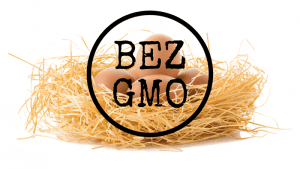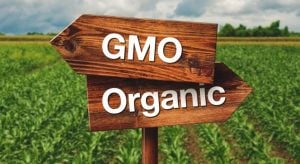 Easter is approaching. Without a doubt, each shopping basket will contain some eggs. Of course, the best choice are unlabeled eggs from a countryside hen that roams freely around the yard. However, not everyone has the opportunity to buy such eggs. I suspect that many people are already aware that from reading the egg code, we can find out whether the eggs are free range or, for example, from cage breeding. Many people who care about the environment and healthy nutrition are guided by this information when choosing eggs. Some also pay attention to the fact whether the eggs come from hens fed with GMO-free feed. And now we get to few questions: what exactly is GMO? Are GMO crops really harmful to us? Can an egg from a hen fed with GMO feed be dangerous to our health? I will try to answer these and other questions regarding GMOs.
Easter is approaching. Without a doubt, each shopping basket will contain some eggs. Of course, the best choice are unlabeled eggs from a countryside hen that roams freely around the yard. However, not everyone has the opportunity to buy such eggs. I suspect that many people are already aware that from reading the egg code, we can find out whether the eggs are free range or, for example, from cage breeding. Many people who care about the environment and healthy nutrition are guided by this information when choosing eggs. Some also pay attention to the fact whether the eggs come from hens fed with GMO-free feed. And now we get to few questions: what exactly is GMO? Are GMO crops really harmful to us? Can an egg from a hen fed with GMO feed be dangerous to our health? I will try to answer these and other questions regarding GMOs.
What is GMO? What is the scale of GMO crops?
A genetically modified organism (GMO) is an organism in which the genetic material has been altered in a non-natural manner by replacing, adding or disabling a gene or several genes. To be clear, GMO is a direct laboratory interference in DNA. GMO is not a crossbreeding of different species, it is not an inbred breed, i.e. mating relatives
GMO mainly concerns plant organisms. The most often modified plants are soybeans, cotton and corn. Tomatoes are also genetically modified so that they are not too soft when ripe. In the United States, most crops are GMO crops:
- 94% of US soybean crops are GMOs with better resistance to pests
- 91% of cotton crops in the USA are GMOs with better resistance to pests
- 89% of corn crops in the US are GMOs with better resistance to pests
 Outside the United States, GMOs are licensed in 27 countries, of which Brazil, Argentina, India and Canada are in the lead. The area which is currently allocated for cultivation of GMOs around the world accounts for 181.5 million hectares. However, Europe still has a relatively small share in GMO crops. In the EU, the only authorised plant for GMO crops is MON810 corn, which accounts for 1% of corn cultivation in Europe. In many European Union countries there is a ban on cultivation of GMOs (including Poland). Spain, on the other hand, does not belong to this group, and Spain’s GMO crops account for 92% of all GMO crops in Europe.
Outside the United States, GMOs are licensed in 27 countries, of which Brazil, Argentina, India and Canada are in the lead. The area which is currently allocated for cultivation of GMOs around the world accounts for 181.5 million hectares. However, Europe still has a relatively small share in GMO crops. In the EU, the only authorised plant for GMO crops is MON810 corn, which accounts for 1% of corn cultivation in Europe. In many European Union countries there is a ban on cultivation of GMOs (including Poland). Spain, on the other hand, does not belong to this group, and Spain’s GMO crops account for 92% of all GMO crops in Europe.
Are GMOs really harmful to us?
This question is probably the most controversial … In October last year an interesting scientific article describing the harmfulness of GMOs was published. About 5% of attempts testing the safety of GMOs report the harmfulness of these organisms. Of course, these studies are used for hot political debates and serve organisations protecting the environment. However, after careful analysis of these studies, it turns out that as much as 40% of publications are financed by anti-GMO organisations. In addition, there is a tendency that these studies are published in less-significant journals, and the research itself is carried out in newly-opened laboratories. Moreover, the vast majority of research is subject to serious methodological errors or incorrect statistical tests are used to show the harmfulness of GMOs on animals. The authors of the review also emphasised that up to now (since the beginning of GMO cultivation) no single scientific report has been published that talks about the adverse health effects of GMOs on the human body. I will emphasise the word “scientific report”, because gossip reports exist of course. For example, in January 2015 the World News Daily Report published an article about the first case of death caused by GMOs confirmed by doctors. A 31-year-old man was to die in a Madrid hospital because of an anaphylactic attack caused by eating a tomato with a fish gene. Everything is great, but even the rules of the website itself say that the information published is fiction and untruthful anecdotes …
 Nevertheless, both the media and fear of the unknown do their own. Why do I mention “fear of the unknown” here? It turns out that only 42-48% of Americans are aware that GM grains are present in the daily sale of food products. We also have available statistics from Poland. It turns out that 57.4% of Poles have doubts about the reliability of research into the safety of GMOs, while at the same time 81.4% of Poles declare that they know very little about GMOs. In general, as many as 59.9% of Poles have a negative opinion on GM plants.
Nevertheless, both the media and fear of the unknown do their own. Why do I mention “fear of the unknown” here? It turns out that only 42-48% of Americans are aware that GM grains are present in the daily sale of food products. We also have available statistics from Poland. It turns out that 57.4% of Poles have doubts about the reliability of research into the safety of GMOs, while at the same time 81.4% of Poles declare that they know very little about GMOs. In general, as many as 59.9% of Poles have a negative opinion on GM plants.
Are we able to determine if the farmed animal was fed with GMO feed?
The answer is positive – yes, we can. Most proteins of GM grains break down during the digestive processes of the animal digestive tract. Nevertheless, some of the GMO proteins can be found in undigested residues in the large intestine and thus in the feces of animals fed with GMO feed. In addition, absorption of DNA fragment derived from GMOs may occur through incomplete disintegration of the protein in the gastrointestinal tract. This fragment is transferred along with the blood to the tissues and organs of the animal.
Also, when eating meat products of an animal fed with GMO feed, we may encounter genetically modified DNA fragments. On the other hand, through the laboratory analysis of meat, we are able to determine whether the animal was fed with GMO feed. Farmers are also unable to mislead reality, and whether or not they use GMO feed can be relatively easily determined.
Can the milk or eggs of an animal fed with GMO feed contain GM DNA?
The answer is also simple, but this time it is negative. No genetically modified DNA fragments were identified in animal products such as eggs or milk. It is not possible to transfer GM DNA fragments to animal products. However, many egg producers include the following information: “eggs from hens fed with GMO-free feed”. From the point of view of our health, this is practically useless information. There is, of course, the issue of environmental protection, however, this topic is so multi-layered and controversial that it is definitely suitable for a separate article.
 To sum up, we have no grounds for health concerns about the consumption of eggs or dairy products from hens fed with GMO feed. In fact, GM DNA fragments can be indeed found in meat and meat products. Therefore, if you are afraid of long-term changes, remember that Polish and European Union law imposes the labeling of products with GMOs.
To sum up, we have no grounds for health concerns about the consumption of eggs or dairy products from hens fed with GMO feed. In fact, GM DNA fragments can be indeed found in meat and meat products. Therefore, if you are afraid of long-term changes, remember that Polish and European Union law imposes the labeling of products with GMOs.
The website of the Chief Sanitary Inspectorate provides more information on the labeling of genetically modified food. You will learn, among others, that:
- foods in the Union Register of Genetically Modified Food and Feed may be on the European Union market, including Poland, provided that it is labeled in accordance with the provisions of Regulation (EC) No 1829/2003.
- in accordance with art. 13 of the above regulation, the labeling of a food product that contains or consists of GMOs, is produced or contains ingredients produced from GMOs should include the following information: “genetically modified”, “produced from genetically modified (name of ingredient)”, “contains genetically modified (name of the organism) “, “contains (name of the ingredient) produced from genetically modified (the name of the organism) “.
- GMO products not exceeding 0.9% (components considered separately or as a single component) are exempt from the marking requirement, provided that this presence is unintentional or technically unavoidable (otherwise marking is obligatory).
Sanchez MA, Parrott WA. (2017) Characterization of scientific studies usually cited as evidence of adverse effects of GM food/feed. Plant Biotechnol J. 15(10): 1227-1234.
Wunderlich S, Gatto KA. (2015) Consumer perception of genetically modified organisms and sources of information. Adv Nutr. 6(6): 842-51.
Nadal A, De Giacomo M, Einspanier R, Kleter G, Kok E, McFarland S, Onori R, Paris A, Toldrà M, van Dijk J, Wal JM, Pla M. (2017) Exposure of livestock to GM feeds: Detectability and measurement. Food Chem Toxicol.
https://gis.gov.pl/zywnosc/zywnosc-genetycznie-zmodyfikowana

